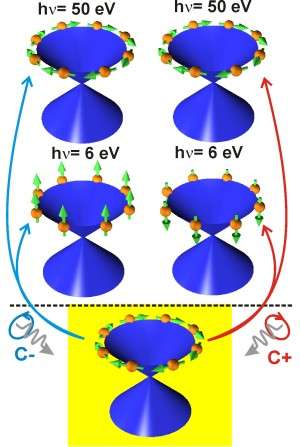Controlling electron spins by light

Topological insulators are considered a very promising material class for the development of future electronic devices. A research team at Helmholtz-Zentrum Berlin has discovered, how light can be used to alter the physical properties of the electrons in these materials. Their results have just been published by the renowned journal Physical Review X.
The material class of topological insulators has been discovered a few years ago and displays amazing properties: In their inside, they behave electrically insulating but at their surface they form metallic, conducting states. The electron spin, i. e., their intrinsic angular momentum, is playing a decisive role. Their sense of rotation is directly coupled to their direction of movement. This coupling leads not only to a high stability of the metallic property but also enables a particularly lossless electrical conduction. Topological insulators are, therefore, considered interesting and promising candidates for novel devices in information technology.
A particularly innovative approach is to try and influence the electron spin at the surface in such devices by light. HZB researcher Prof. Oliver Rader and his team have discovered by which means the spin at the surface of topological insulators can be altered. To this end, the researches performed experiments with light of various energies or wavelengths.
The wavelenght counts
At the synchrotron radiation source BESSY II they investigated the topological insulator bismuth selenide (Bi2Se3) using a method called "spin-resolved photoelectron spectroscopy" – and gained astonishing insights: They found an astonishing difference depending on whether the electrons at the surface of the material are excited with circularly polarized light in the vacuum ultraviolet (50-70 electron volts, eV) or in the ultraviolet spectral range (6 eV). They could demonstrate that they can measure the spin of the electrons without changing it at higher energies which are typically used at synchtrotron light sources. "When excited at 50 eV, the emitted electros display the typical spin texture of topological insulators", Dr. Jaime Sánchez-Barriga, who conducted the experiments, explains. "The electron spins are in the surface aligned on a circle, similarly to a traffic sign for roundabout." This is the ground state of the electrons in the surface of topological insulators."
When excited by low-energy circularly polarized photons (6 eV), the spin of the electrons moved completely out of the surface plane. Above all, they adopted the spin orientation imposed by the right- or left-circularly polarized light. This means that the spin can be systematically manipulated – depending on the light that is used. The scientists can also explain the entirely different behavior at different energies which they attribute to symmetry properties. "Our result delivers important insight how lossless currents could be induced in topological insulators", Oliver Rader explains. "This is important for the development of so-called optospintronic devices which could enormously enhance the speed at which information is stored and processed."
More information: Photoemission of Bi2Se3 with Circularly Polarized Light: Probe of Spin Polarization or Means for Spin Manipulation? Phys. Rev. X 4, 011046 – Published 24 March 2014; J. Sánchez-Barriga, A. Varykhalov, J. Braun, S.-Y. Xu, N. Alidoust, O. Kornilov, J. Minár, K. Hummer, G. Springholz, G. Bauer, R. Schumann, L. V. Yashina, H. Ebert, M. Z. Hasan, and O. Rader.
Journal information: Physical Review X
Provided by Helmholtz Association of German Research Centres



















